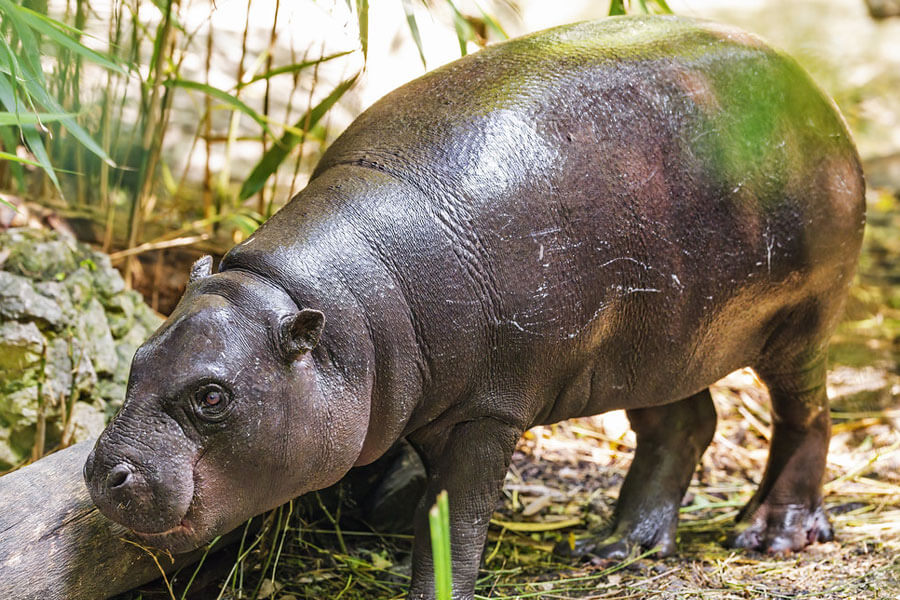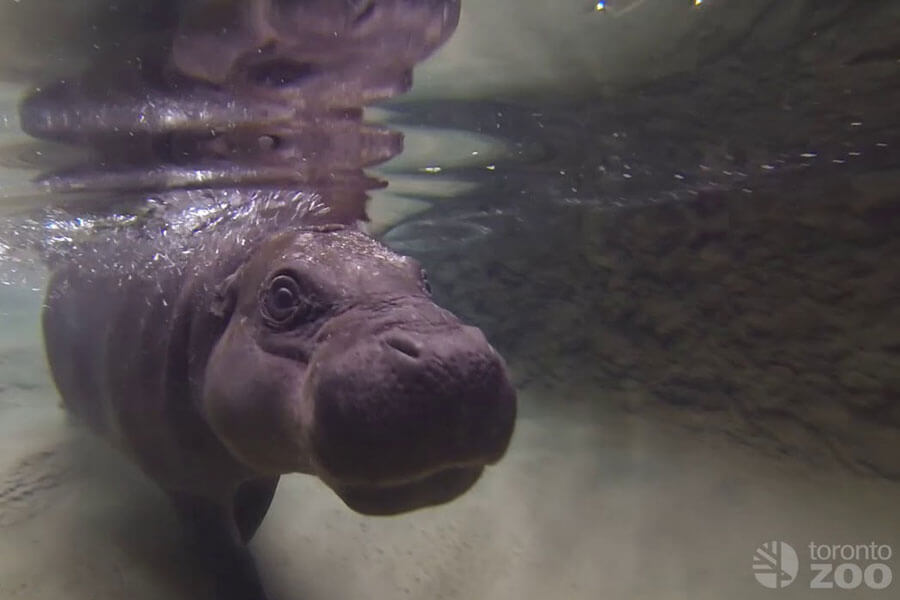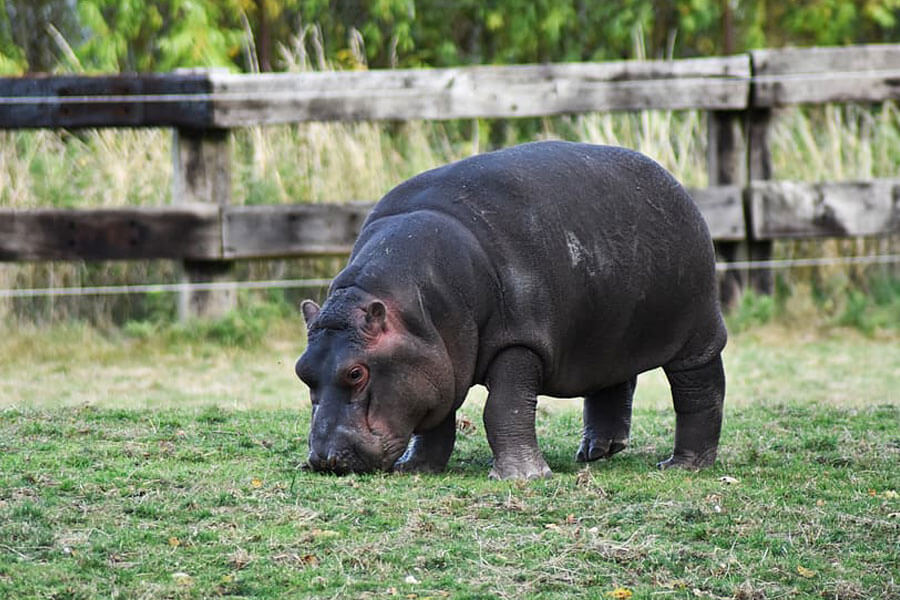Welcome to the enchanting world of the pygmy hippo, an elusive and fascinating creature that roams the dense forests of West Africa. Often overshadowed by its larger cousin, the common hippopotamus, the pygmy hippo possesses its unique charm and mystique.
In this article, we will delve into the diet, habitat, threats, conservation efforts, and much more surrounding the remarkable pygmy hippopotamus.
Facts About Pygmy Hippos
1. Physical Description
The pygmy hippo is a small-sized mammal, standing at just over two feet tall at the shoulder and measuring around five feet in length. Unlike its larger relative, it weighs significantly less, usually ranging between 400 and 600 kilograms (880 to 1,320 pounds).

This endearing animal is characterized by its barrel-shaped body, short legs, and distinctive rounded head adorned with wide-set eyes and small ears. Its thick, smooth skin acts as a protective shield against the dense vegetation it navigates.
In very simple terms, the pygmy hippo is a much smaller version of the common hippo - with slightly different features.
2. Habitat
Pygmy hippos are native to the dense forests and swamps of West Africa, including countries such as Liberia, Sierra Leone, Guinea, and Ivory Coast. They thrive in areas with proximity to water sources, such as rivers, streams, and marshes.
These semi-aquatic mammals have a remarkable ability to move through water, aided by their muscular bodies and webbed toes, which facilitate swimming and foraging.

3. Weight & Size
Compared to their larger counterparts, pygmy hippos are really small. They stand just over two feet tall at the shoulder and measure around five feet in length.
Their weight ranges from 400 to 600 kilograms (880 to 1,320 pounds), making them about one-fourth the size of common hippos.
Here is a picture showing the size comparison of a pygmy hippo with its larger cousin, the common hippo.

While small size might not have so many advantages in the savannah where the common hippo commands respect, it is perfect for manoeuvring through the rainforest habitat with thick undergrowth - and fewer big predators - except for the leopard.
4. Diet & Eating Habits
Pygmy hippos are primarily herbivores and only feed on a variety of plant materials found in their rainforest habitats. They have a broad diet, consuming leaves, fruits, grasses, and even some aquatic vegetation.
This variety in food sources makes the pygmy hippo's diet arguably healthier than that of its larger cousin in the savannah.
Their elongated snout and powerful jaws allow them to grasp and chew their food with precision. Despite their diminutive size, pygmy hippos can consume up to 40 pounds of vegetation in a single night of feeding.
5. Social Structure
The pygmy hippo is a solitary animal, and males and females only come together to mate. This solitary lifestyle allows the pygmy hippo to avoid competition for food and other resources and helps to ensure that its populations remain healthy and stable.
Mothers will be seen with their young offspring but like most forest-dwelling animals, adults are rarely seen together unless it's for mating reasons.

6. Communication
The pygmy hippo is a vocal animal and is known for its loud, guttural grunts and snorts. These sounds are used to communicate with other pygmy hippos and to warn off potential predators.
7. Reproduction
Female pygmy hippos (cows) often give birth to a single calf after a gestation period of 6 to 7 months. The calf is born quite developed and capable of walking and swimming within a few hours after birth.
Young calves will rely a lot on their mothers for nourishment and protection for around 2 years. After this, they can live quite easily on their own. Pygmy hippos reach sexual maturity between 3 and 5 years of age.
8. Threats
Like many wild animals in Africa's wilderness, the biggest threat to survival is human pressure. In the case of pygmy hippos, the destruction and fragmentation of rainforests directly affect their food sources and create an immediate danger for survival.
Furthermore, pygmy hippos also face another direct threat from poaching where they are killed for bush meat. Due to their smaller size, the pygmy hippo doesn't pose as much of a risk to poachers as does the bigger and more powerful common hippo in the savannah.
Related article: Africa's Most Endangered Wild Animals
9. Conservation
According to the IUCN, the pygmy hippopotamus is classified as Endangered. This means that the threat to its survival is serious and urgent conservation action should be taken to ensure the stability of the populations and their natural ecosystems in the wild.
It is estimated that there are less than 3,000 pygmy hippos left in the wild. This number is very small and given how rainforest and aquatic ecosystems are fragile, pygmy hippos in the wild could easily go extinct in a future not so far away.
Actions such as awareness, conservation research and monitoring, involving the local communities and legal frameworks can help protect these animals - and the places they call home.
Sustainable tourism is a good way of contributing to the protection of wild places where these and many other animals live. When the value of such rainforest is seen through tourism, the human effort that was previously a threat turns into a collaborative hand.
Conclusion
The pygmy hippo is a captivating creature that captivates the hearts of those fortunate enough to encounter it. Its small stature belies its significance in the intricate tapestry of African wildlife.
As we strive to protect and conserve this charismatic species, we not only safeguard a remarkable example of natural diversity but also ensure the conservation of its unique habitat and the countless other species that call it home.
